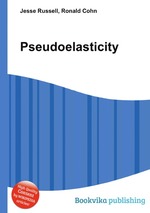Pseudoelasticity
Jesse Russell Ronald Cohn
бумажная книга
High Quality Content by WIKIPEDIA articles! Pseudoelasticity, sometimes called superelasticity, is an elastic (reversible) response to an applied stress, caused by a phase transformation between the austenitic and martensitic phases of a crystal. It is exhibited in shape-memory alloys. Pseudoelasticity is from the reversible motion of domain boundaries during the phase transformation, rather than just bond stretching or the introduction of defects in the crystal lattice (thus it is not true superelasticity but rather pseudoelasticity). Even if the domain boundaries do become pinned, they may be reversed through heating. Thus, a pseudoelastic material may return to its previous shape (hence, shape memory) after the removal of even relatively high applied strains. One special case of pseudoelasticity is called the Bain Correspondence. This involves the austenite/martensite phase transformation between a face-centered crystal lattice and a body-centered tetragonal crystal structure.


